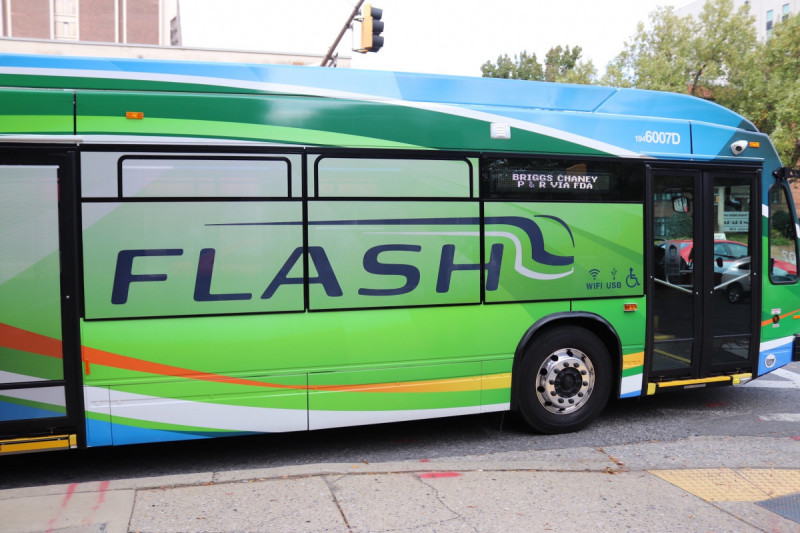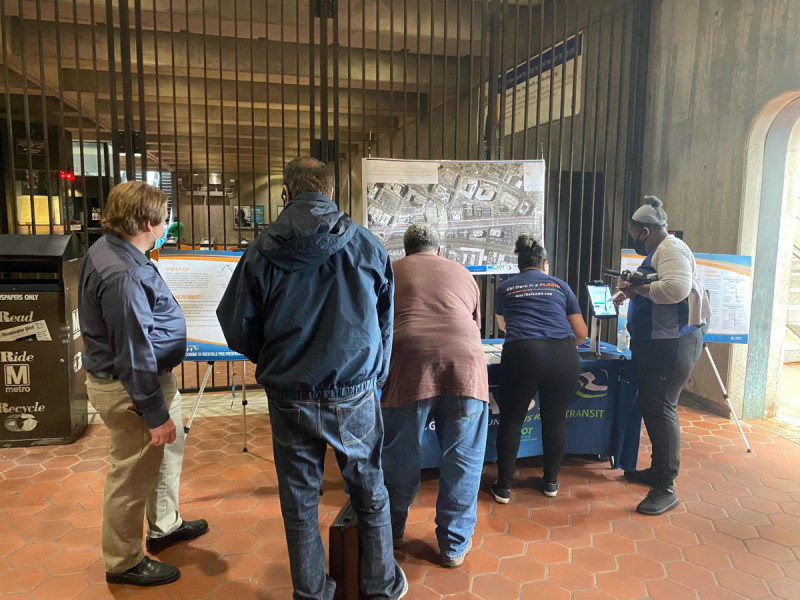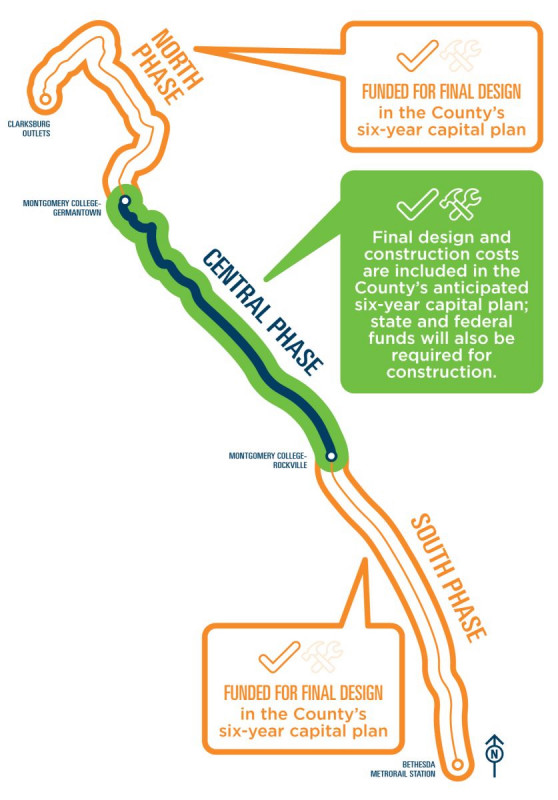Pop-up events let riders voice their preferences for Flash BRT on Route 355

A Flash bus in Silver Spring, Md. by Elvert Barnes licensed under Creative Commons.
Community outreach is changing. The old way of doing business, at set times in local-government buildings, meant the same few people with time, and groups with special interests, dominated. The new way is to meet the people where they are.
For Montgomery County’s planned Flash Bus Rapid Transit (BRT) along Route 355, this means 13 pop-up events at Metro stations and grocery stores, 4 online meetings, and even a telephone with office hours. Expected to run from Bethesda to Clarksburg, the 355 Flash is one of five BRT lines in the works; the first, along Route 29 in east county, has been up and running for more than a year. Design work and engineering for the 355 Flash BRT will continue for the next three years, with construction to begin in 2025, although that is not fully funded.
The first pop-up event took place on May 25 at Rockville Station. When I stopped by at 3 pm, there was a small but interested crowd, generating a notable buzz, gathered around a table with placards describing the service, along with two electronic stations. Montgomery County DOT staff discussed the service with several passers-by.
The remaining dozen pop-ups will take place from June 1 to June 19, and are listed on the project website.
“Our goal is to talk to riders, people who use our services who will see real benefits from this project,” said Darcy Buckley, Planning and Engagement Specialist at Montgomery County Department of Transportation (MCDOT). “We’re trying to do outreach in all different ways,” she added, to bring “a variety of voices, and much more diversity.”
The idea is to reach people who may be too busy working multiple jobs and taking care of family to attend traditional meetings, or who may just be intimidated or feel their voice will not be heard. Such individuals, often low-income, Black or brown, may most depend on public transit.
A pop-up event at the Rockville station. Image by Darcy Buckley. 
A pop-up event at the Rockville Station station. Image by MCDOT.
The outreach will get “transit riders’ view, their business, destinations, work to home, daycare, that kind of insight,” said Buckley. Talking to people so far, she said, they are excited; the “biggest complaint is that it’s not going to be here tomorrow, because everything takes time.”
While it’s too early to assess feedback from the 355 Flash meetings, Buckley pointed to a previous project where on-the-ground users said that a proposed bus stop would not be safe, leading to design changes. Undoubtedly, many more details reflecting people’s everyday lives—where to locate stops, how to make them accessible on foot or by bicycle, safety issues, lighting, best times for service, and more—will come up as the outreach continues.
The central portion of the project has the highest projected ridership and will be built first. Image by MCDOT.
A critical project for equity
The first part of the 355 Flash planned is the central segment, from Montgomery College, Rockville to Montgomery College, Germantown, which has “existing really high ridership. There’s a huge demand for better service,” said Buckley, and the corridor meets the county’s equity emphasis on “low-income and minority populations.” The idea is to accommodate people who have “irregular hours or are working multiple jobs and are taking transit to go a bunch of different places.” This segment is not serviced by the Red Line, with the exception of the Shady Grove station.
Often, the most controversial part of a BRT project is providing dedicated lanes, allowing buses to speed by existing traffic and drawing higher ridership. The central part of 355 Flash will have a dedicated bi-directional median lane along much of it, said Buckley. The lane will be reversed to go with the flow of traffic.
Still, much of the entire project, including the northernmost segment, is planned to run in mixed traffic, slowing the buses. “As we progress with the design, we’ll continue to look for opportunities to increase the amount of dedicated lanes,” said Buckley. “The current design has approximately 50% of the entire corridor in dedicated lanes.”
While such lanes may be intermittent, the plan does include many other elements recommended by the Institute for Transportation and Development Policy for high-quality BRT. Having buses in center lanes means “fewer conflicts with turning vehicles.” Flash also has off-board fare collection, platform level boarding, multiple doors on buses, safe and comfortable stations, among recommended features.
Repurposing lanes—that is, taking a lane away from cars—is not in current plans. Dedicated lanes will be added through reengineering. Still, Buckley said that repurposing may be possible depending on a variety of actors from the state on down. Planning is a long process with plenty of input, including these pop-up forums to meet the riders who will most depend on the new service.
